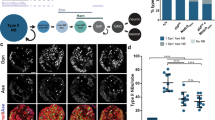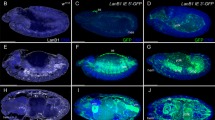Abstract
A DROSOPHILA pair-rule segmentation gene, fushi tarazu (ftz), encodes a protein which is expressed in a characteristic seven-stripe pattern1. The promoter sequences that are sufficient for generating this spatially restricted pattern of expression are located within 669 base pairs upstream of the transcription start site2. Multiple transcriptional activators and repressors interact with this 'zebra-stripe' promoter unit to bring about the positional specificity of ftz transcription3. Here we report that the homoeodomain-containing protein encoded by caudal (cad) is one such regulator. The cad gene product can increase the level of ftz transcription in the posterior half of the embryo by interacting with multiple copies of a TTTATG consensus sequence located in the zebra-stripe unit. This result demonstrates one pathway by which the product of a maternally expressed segmentation gene, expressed in an antero-posterior concentration gradient, can directly regulate the expression of a pair-rule gene.
This is a preview of subscription content, access via your institution
Access options
Subscribe to this journal
Receive 51 print issues and online access
$199.00 per year
only $3.90 per issue
Buy this article
- Purchase on Springer Link
- Instant access to full article PDF
Prices may be subject to local taxes which are calculated during checkout
Similar content being viewed by others
References
Caroll, S. B. & Scott, M. P. Cell 43, 47–57 (1985).
Hiromi, Y., Kuroiwa, A. & Gehring, W. J. Cell 43, 603–613 (1985).
Dearolf, C. R., Topol, J. & Parker, C. S. Genes Dev. 3, 384–398 (1989).
Macdonald, P. M. & Strühl, G. Nature 324, 537–545 (1986).
Mlodzik, M. & Gehring, W. J. Cell 48, 465–478 (1987).
Mlodzik, M., Fjose, A. & Gehring, W. J. EMBO J. 4, 2961–2969 (1985).
Serfling, E. Trends Genet. 5, 131–133 (1989).
Jaynes, J. B. & O'Farrell, P. H. Nature 336, 744–749 (1988).
Desplan, C., Theis, J. & O'Farrell, P. H. Cell 54, 1081–1090 (1988).
Krasnow, M. A., Saffman, E. E., Kornfeld, K. & Hogness, D. S. Cell 57, 1031–1043 (1989).
Hiromi, Y. & Gehring, W. J. Cell 50, 963–974 (1987).
Doyle, H., Kraut, R. & Levine, M. Genes Dev., in the press.
Ingham, P. W., Ish-Horowicz, D. & Howard, K. EMBO J. 5, 1659–1665 (1986).
Tautz, D. Nature 332, 281–284 (1988).
Driever, W. & Nüsslein-Volhard, C. Nature 337, 138–143 (1989).
Harding, K., Hoey, T., Warrior, R. & Levine, M. EMBO J. 8, 1204–1212 (1989).
Goto, T., Macdonald, P. & Maniatis, T. Cell 57, 413–422 (1989).
Howard, K., Ingham, P. & Rushlow, C. Genes Dev. 2, 1037–1046 (1988).
Studier, F. W. & Moffatt, B. A. J. molec. Biol. 189, 113–130 (1986).
Hoey, T., Warrior, R., Manak, J. & Levine, M. Molec cell. Biol. 8, 4598–4607 (1988).
Parker, C. S. & Topol, J. Cell 36, 357–369 (1984).
Simon, J. A. & Lis, J. T. Nucleic Acids Res. 15, 2971–2984 (1987).
Author information
Authors and Affiliations
Rights and permissions
About this article
Cite this article
Dearolf, C., Topol, J. & Parker, C. The caudal gene product is a direct activator of fushi tarazu transcription during Drosophila embryogenesis. Nature 341, 340–343 (1989). https://doi.org/10.1038/341340a0
Received:
Accepted:
Issue Date:
DOI: https://doi.org/10.1038/341340a0
This article is cited by
-
Activation of posterior gap gene expression in the Drosophila blastoderm
Nature (1995)
-
Structure and regulation of the fushi tarazu gene from Drosophila hydei
Roux's Archives of Developmental Biology (1995)
Comments
By submitting a comment you agree to abide by our Terms and Community Guidelines. If you find something abusive or that does not comply with our terms or guidelines please flag it as inappropriate.



